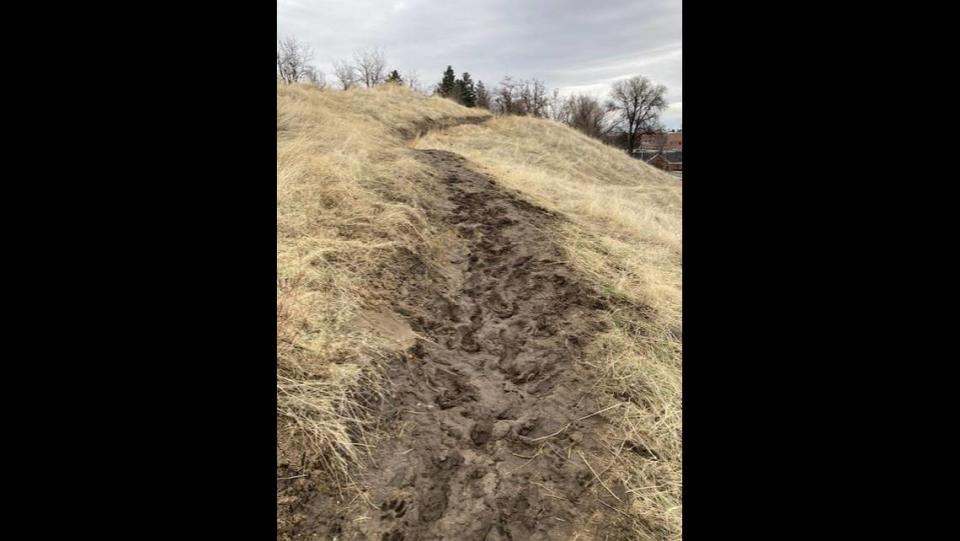Boise Foothills trails ‘virtually destroyed’ as hikers use muddy routes, officials say
Several Boise Foothills trails have been heavily damaged by use in wet, muddy conditions, trail management officials said Thursday.
Ridge to Rivers, the agency that manages Boise’s 250-plus miles of trails, documented the damage in a series of Facebook posts in recent days. On Wednesday, the agency said Tram Trail, which begins on Warm Springs Boulevard near Warm Springs Golf Course, has been “virtually destroyed.” Accompanying photos show deep ruts in the damp trail, with bicycle tire treads and footprints apparent.
David Gordon, Ridge to Rivers director, told the Idaho Statesman in a phone interview that trails appear to be in worse condition now than in previous years. The agency has pleaded with trail users in recent years to only use trails when they’re dry or frozen. Clay-heavy soils in the Treasure Valley are prone to erosion, Gordon said, and the ruts created in wet or muddy trails remain when the trails dry.
Gordon called the conditions on Tram “shocking” and said Ridge to Rivers employees have confirmed similar damage on several other trails.

“Table Rock is pretty destroyed, like it is every year, unfortunately,” Gordon said. “Cottonwood’s the same. The bottom of Kestrel is awful. Take your pick.”
For several years, Ridge to Rivers closed Table Rock — one of the system’s most popular and most clay-heavy trails — when winter conditions were poor. It stopped that program in 2020 after efforts proved ineffective.
“People were just climbing over the gate, climbing over the fence and hiking it anyway,” Gordon said.
This year, Ridge to Rivers has closed the bottom half of Ridgecrest Trail in the Military Reserve and the Old Pen Trail that parallels Table Rock No. 15. Gordon said the agency might close Heroes, a new addition at the western edge of the Military Reserve.
Gordon said trails in the Foothills are difficult to close because so many of them interconnect, creating many access points.
“The reality is we can’t close a whole lot of trails,” he said. “You’re only somewhat effective, as our Table Rock experience showed us.”
Education or enforcement?
Ridge to Rivers has focused on educating hikers about when to use trails. In November, it launched an interactive trail conditions map on its website to allow users to see which trails are in poor shape. Ridge to Rivers also posts daily trail condition reports on its Facebook page, and Gordon said it recently installed trailhead signs featuring QR codes so users could check that trail’s condition before heading out.
“What we’re doing, clearly it’s not successful,” Gordon said. “And we have tried so many new things.”
On Facebook, commenters called for additional trail closures as well as enforcement of those closures.
“Time to start writing tickets,” wrote Eric Copeland.
“It’s blatantly obvious this is bad for the trails, but people don’t care,” wrote user Hunter WB. “R2R needs to use a stick instead of relying on carrots.”
Gordon said it’s not that simple.
“We’re doing everything we can short of policing the trails which ... there’s nothing to police because there’s no law to enforce,” he said.
He said part of the problem is an overall increase in trail usage in recent years. Many trail users are also new to the Boise area and aren’t aware of the potential damage they can cause, he added.
Weather has also played a role. Warmer winters have kept trails from freezing or caused trails to freeze overnight and thaw during the day, creating muddy conditions.
Gordon said he’s not sure what Ridge to Rivers will try next. He said the problem is complex and again asked trail users to check conditions and turn back if they encounter wet or muddy trails.
When people hike or bike on muddy trails, they churn up the path. Gordon said some tracks are 4 or 5 inches deep.
“It’s like, ‘I can’t believe you’re not turning back,’” he said.
Walking off-trail is also damaging. People who leave the trail to walk around muddy sections tread on sensitive vegetation and can cause trails to widen or braid — when multiple paths weave together. Gordon said in some instances, hikers are breaking down the edge of the trail structure, which can make routes susceptible to crumbling off the side of the Foothills.
Ridge to Rivers has staff and volunteers who do regular trail maintenance and repairs, but Gordon said the extent of the current trail damage is difficult to address.
“We can’t fix this,” he said. “We don’t have the ability to go along these long stretches of trail and smooth them all out. The damage that’s occurring is what’s going to be left for people to use later in the year and into the future.”

